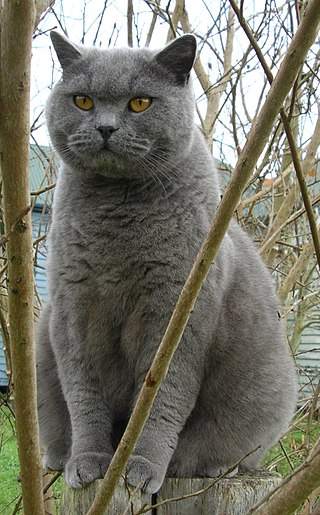
The British Shorthair is the pedigreed version of the traditional British domestic cat, with a distinctively stocky body, thick coat, and broad face. The most familiar colour variant is the "British Blue", with a solid grey-blue coat, pineapple eyes, and a medium-sized tail. The breed has also been developed in a wide range of other colours and patterns, including tabby and colourpoint.
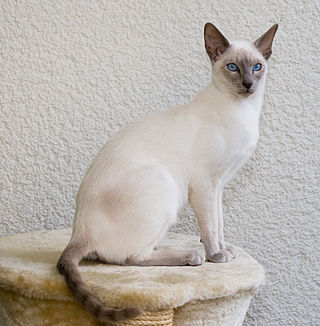
The Siamese cat is one of the first distinctly recognised breeds of Asian cat. It derives from the Wichianmat landrace. The Siamese cat is one of several varieties of cats native to Thailand. The original Siamese became one of the most popular breeds in Europe and North America in the 19th century. Siamese cats have a distinctive colourpoint coat, resulting from a temperature-sensitive type of albinism.

The Maine Coon is a large domesticated cat breed. One of the oldest natural breeds in North America, the breed originated in the U.S. state of Maine, where it is the official state cat.

The Exotic Shorthair is a breed of cat developed as a short-haired version of the Persian. The Exotic is similar to the Persian in appearance with the exception of the short dense coat.

The Munchkin is a breed of cat characterized by its very short legs, which are caused by a genetic mutation. Compared to many other cat breeds, it is a relatively new breed, documented since 1940s and officially recognized in 1991. The Munchkin is considered to be the original breed of dwarf cat.

The Himalayan, is a breed or sub-breed of long-haired cat similar in type to the Persian, with the exception of its blue eyes and its point colouration, which were derived from crossing the Persian with the Siamese. Some registries may classify the Himalayan as a long-haired sub-breed of Siamese, or a colorpoint sub-breed of Persian. The World Cat Federation has merged them with the Colorpoint Shorthair and Javanese into a single breed, the Colorpoint.

The Chantilly-Tiffany or Chantilly/Tiffany, also known as the Chantilly or the Foreign Longhair, was a breed of domestic cat which originated in the late-1960s in North America. The Chantilly breed never got off the ground and has always been rare. It was near-extinction in the late-1980s and again in the late-2000s. Since 2015 the breed has been considered extinct with the passing and neutering of the last two cats of the Chantilly lineage, and with no intact Chantilly cats the inevitable resulting discontinuation of the breeding program.

Haughton-le-Skerne is a village in the borough of Darlington in the ceremonial county of Durham, England. It is situated in the north east of Darlington. The village lies to the west of the River Skerne. At the centre of the village green, is the main road towards Darlington town centre going across the river, south of the church. There used to be a linen mill on the riverbank on the east side of the village. Part of the mill leat can still be seen today.

Harrison William Weir, known as "The Father of the Cat Fancy", was a British artist.
A cat registry or cat breed registry, also known as a cat fancier organization, cattery federation, or cat breeders' association, is an organization that registers domestic cats of many breeds, for exhibition and for breeding lineage tracking purposes. A cat registry stores the pedigrees (genealogies) of cats, cattery names, and other details of cats; studbooks, breed descriptions, and the formal breed standards ; lists of judges qualified to judge at shows run by or affiliated with that registry, and sometimes other information. A cat registry is not the same as a breed club or breed society. Cat registries each have their own rules and usually also organize or license (sanction) cat shows. The show procedures vary widely, and awards won in one registry are not normally recognized by another. Some registries only serve breeders, while others are oriented toward pet owners and provide individual as well as cattery memberships, while yet others are federations only deal with breed clubs or even other registries as intermediaries between the organization and breeders.
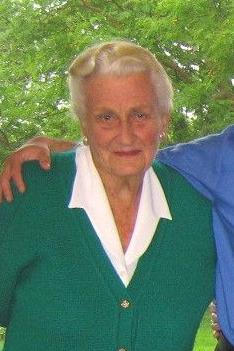
Cecily Bourchier Norden was an author, senior horse judge, champion rider and exhibitor and stud breeder. She is known for her contribution to the riding horse industry in South Africa.

Kathleen Florence May Pelham-Clinton, Duchess of Newcastle-under-Lyne OBE, was a well-known conformation show judge and dog breeder who influenced the Borzoi and Wire Fox Terrier breeds.
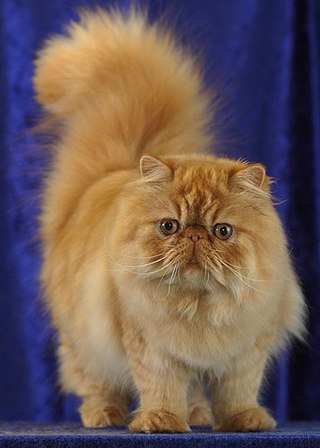
The Persian cat, also known as the Persian Longhair, is a long-haired breed of cat characterised by a round face and short muzzle. The first documented ancestors of Persian cats might have been imported into Italy from Khorasan as early as around 1620, however, this has not been proven. Instead, there is stronger evidence for a longhaired cat breed being exported from Iran from the 19th century onwards. Persian cats have been widely recognised by the North-West European cat fancy since the 19th century, and after World War II by breeders from North America, Australia and New Zealand. Some cat fancier organisations' breed standards subsume the Himalayan and Exotic Shorthair as variants of this breed, while others generally treat them as separate breeds.
Charlotte Frances Wilder was an American writer. She was one of the most widely known writers of Kansas, and the author of many religious books, including for juvenile audiences, and a contributor to church papers and magazines. Her works -included in the Bibliothèque nationale de France, Paris- were "entitled to go down to posterity, her life-work preserved as information for future generations".
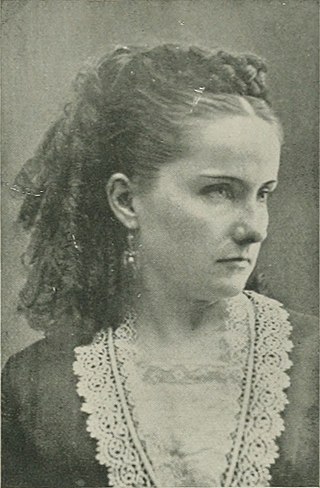
Eunice Gibbs Allyn was an American correspondent, author, songwriter, illustrator, and painter. She intended to become a teacher, but her mother dissuaded her so she remained at home, entering into society, and writing in a quiet way for the local papers while using various pen names in order to avoid displeasing one of her brothers, who did not wish to have a "bluestocking" in the family.

Emma Whitcomb Babcock was an American litterateur and author. She did considerable work as a book reviewer, and contributed to various leading magazines. She was the author of Household Hints, a domestic management guide, and A Mother's Note Book, as well as other works. She was president of The Belles-Lettres club, well known in western Pennsylvania, which founded a public library. Babcock died in 1926.

Helen M. Winslow was an American editor, author, publisher, and journalist. She began her work on Boston papers. Winslow served as dramatic editor on The Beacon, 1891–97; editor, Woman's Club Department, Boston Transcript, 1893–98; editor, Woman's Club Department of the Delineator, 1897, and again 1912; editor and publisher, The Club Woman, 1897-1904; and she was the publisher of the Official Register of Women's Clubs in America from 1897. She was the author of Salome Sheppard, Reformer. 1893; Concerning Cats, 1900; Concerning Polly, 1902; Literary Boston or To-day, 1902; The Woman of To-morrow, 1905; The President of Quex, 1906; Peggy at Spinster Farm, 1908; A Woman for Mayor, 1910; The Pleasuring of Susan Smith, 1912; and At the Sign of the Town Pump, 1913. She collaborated with Frances Willard in Occupations for Women, and with Marie Wright in Picturesque Mexico.
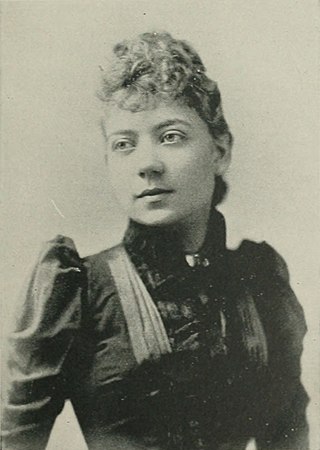
Ruth Ward Kahn was a Jewish American lecturer and writer. In addition to being the author of novel, The Story of Judith (novel), The First Quarter, and "Gertrude", she was a contributor to Woman's Home Companion, Arena, Popular Science, and other publications. She was a member of the Incorporated Society of Authors of London, as well as the Woman's National Press Association, of which she served as the vice-president for its Colorado branch. Kahn's travels took her to Bermuda, Mexico, Hawaii, and the South Sea Islands; she lectured in 20 states.

Jean Mill was an American cat breeder, owner of Millwood cattery. She is best known as the founder of the Bengal cat breed, and also made contributions to the Himalayan and the standardized version of the Egyptian Mau. Mill and her first husband, Robert Sugden, were involved in a precedent-setting case about the United States government's power to monitor short wave radio communications.



















